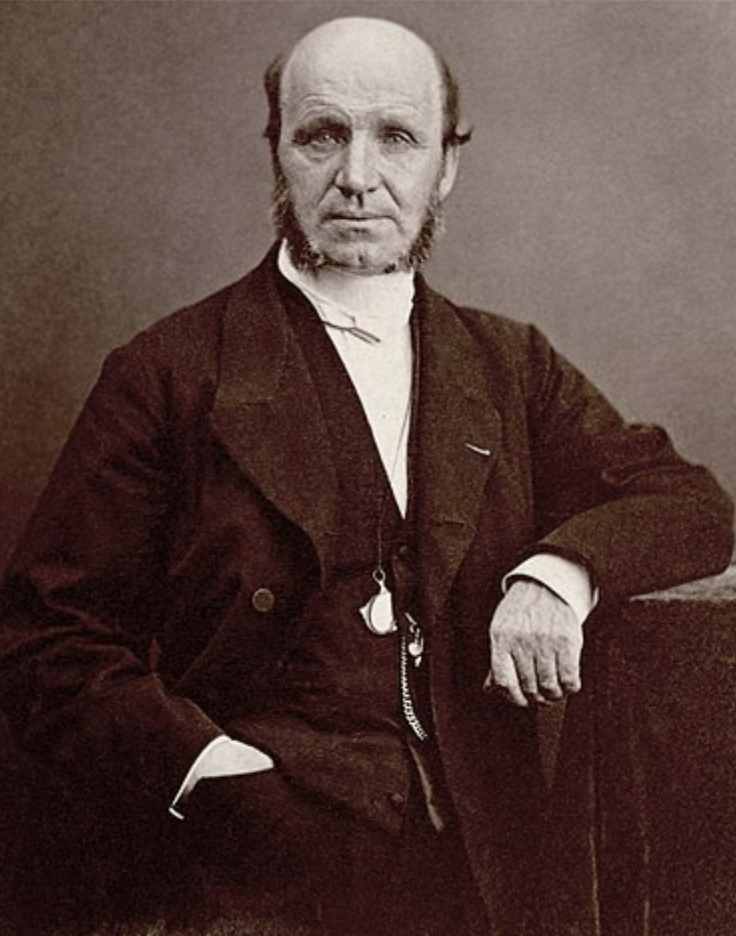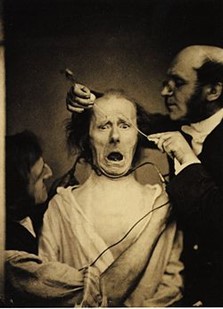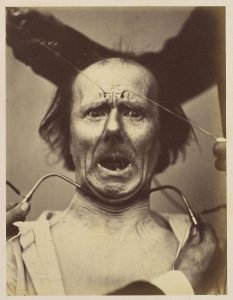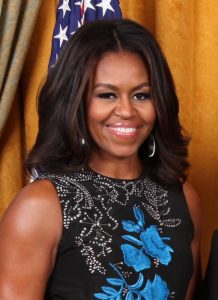Chapter 6: Measuring and Manipulating Emotions
Facial Expressions
In 1872, Darwin theorized that facial expressions in humans and animals uniquely displayed emotional experiences. Before Darwin’s ideas were published, a medical doctor named Guillaume-Benjamin Duchenne de Boulogne proposed the same concept. Unlike Darwin, who was interested in universality and evolution, Duchenne was interested in identifying the anatomy of facial muscles and in using electrical stimulation of facial muscles for treatments of neurological disorders. Instead of observing facial expressions in animals like Darwin, Duchenne used electrical stimulation to manipulate facial expressions that he believed were associated with unique emotions (see Duchenne’s photos below in Figure 3). He is credited with identifying muscular dystrophy and the Duchenne smile, a genuine smile some believe represents pure happiness or joy. A Duchenne smile occurs when both the eyes and mouth change and is different from the Pan-Am smile, which does not show a change in the eyes. The Duchenne smile (see Figure 4) is a genuine, naturally occurring smile that occurs when people experience joy. Conversely, the Pan-Am smile (see Figure 5) is considered a fake, more forced smile that doesn’t represent one’s true emotion. In fact, in Darwin’s (1872) book on The Expressions of Emotion in Man and Animals, Darwin displays Duchenne’s photographs as evidence of discrete facial expressions of emotion. Duchenne is credited with developing the first EMG-like machine. Duchenne’s work was the proponent to the component method.
This MET website provides more photos of Duchenne’s work.
Figure 2
Photo of Guillaume-Benjamin Duchenne de Boulogne, 1806-1875

Figure 3
Photos of Duchenne Manipulating Facial Expressions


Left photo reproduced from “Duchenne electrostimulus photo” by fortinbras. Open Access, CC BY-NC-SA 2.0. Retrieved from: https://search.creativecommons.org/photos/4f3a45b0-cd51-4f92-ba13-e3c9013f6d1d
Right photo reproduced from “Icono-photographique. Mécanisme de la Physionomie Humaine. Fig. 651854–56, printed 1862″ by The MET, Open Access API. Retrieved from: Icono-photographique. Mécanisme de la Physionomie Humaine. Fig. 65
Figure 4
Example of Duchenne Smile

Reproduced from “Michelle Obama in 2014 (cropped)” by Presidency of Kosovo. Open Access, Creative Commons Attribution-Share Alike 4.0 International. Retrieved from File:Michelle Obama in 2014 (cropped).jpg – Wikimedia Commons
Figure 5
Example of Pan-Am Smile


